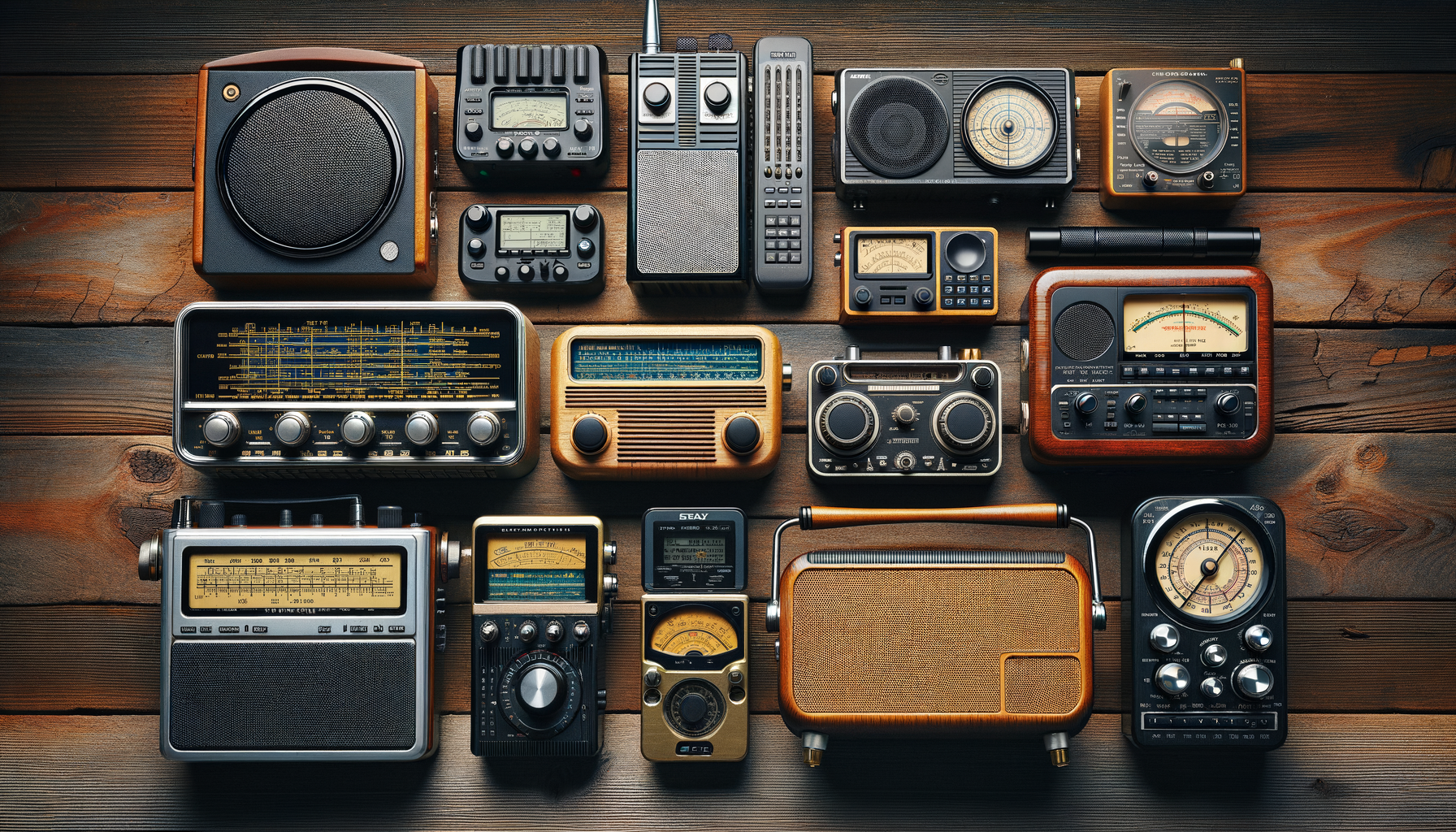
Are you in the market for a new shortwave radio but feel overwhelmed by the plethora of options available? Whether you’re a seasoned Dxer looking to upgrade your gear or a beginner drawn to the world of international broadcasting and amateur radio, selecting the right shortwave radio can be a tricky task. But fear not! We’ve tuned into the frequencies of shortwave radio enthusiasts and experts to bring you detailed and reliable reviews to help you make an informed choice. Let’s explore the captivating world of shortwave radios together and find the best one for your listening pleasure.
Our Top Picks
Our #1 Top Pick: Tecsun PL880 Portable Digital PLL Dual Conversion AM/FM, Longwave & Shortwave Radio
If you’re searching for a portable shortwave radio that combines top-notch performance with user-friendly features, the Tecsun PL880 should be at the top of your list. This radio impresses with its exceptional selectivity and sensitivity, allowing it to lock onto distant stations with clarity and stability. The PL880 boasts a full range of shortwave band coverage, AM/FM capabilities, and even longwave reception, making it an all-in-one device for serious listeners.
One of the standout features is the array of bandwidth filter options, ensuring listeners can fine-tune their reception for the best possible audio quality. Plus, the radio’s digital signal processing technology provides a listening experience that can rival that of much bulkier and pricier tabletop models. The built-in rechargeable battery, complete with a battery level indicator, ensures you’re never left without power at critical listening times.
Pick #2: Sangean ATS-909X BK AM/FM/LW/SW World Band Receiver
The Sangean ATS-909X is a top contender for those who prefer a blend of performance and durability. Its robust design doesn’t just look professional; it protects the device’s sophisticated circuitry. This receiver is well-equipped for global tuning, featuring a wide array of shortwave bands supplemented by AM/FM and longwave capabilities.
Listeners will appreciate the automatic tuning system that can scan and memorize available stations, as well as the manual tuning options for fine adjustments. The ATS-909X has a large, easy-to-read LCD that displays the frequency, signal strength, and a number of other useful indicators. It’s a solid choice for those who want a reliable radio with advanced features, suitable for both novices and experts alike.
Pick #3: Eton Elite Field AM/FM/Shortwave Desktop Radio
Eton Elite Field is a versatile radio that combines the charm of a classic desktop design with contemporary functionalities. This model isn’t just about aesthetics; it’s a powerhouse when it comes to performance. The AM/FM reception is crisp, and the shortwave range is equally impressive, making it a good fit for both everyday listening and the exploration of international broadcasts.
Its large, easy-to-read dial and simple controls cater to users who prefer a more tactile tuning experience. Additionally, the radio’s external antenna support and the capability to connect to external devices via aux-in enhance its versatility. If you enjoy rich sound and robust build quality, the Eton Elite Field is a fantastic choice that caters to both aesthetic and practical desires.
Pick #4: XHDATA D-808 Portable Digital Radio
For those who favor a compact radio without sacrificing performance, the XHDATA D-808 is a standout option. This little powerhouse is capable of AM/FM, shortwave, and even AIR band reception, making it a unique and adaptable companion for travel or home use. Despite its modest size, the D-808 performs admirably in capturing distant stations thanks to its digital signal processing technology.
The radio includes several bandwidth filter settings and a clear display that shows the time, frequency, and signal strength. Its alarm clock and sleep timer functions are convenient extras for anyone using the radio at their bedside. The D-808 is also known for its excellent battery life, ensuring hours of uninterrupted listening.
Pick #5: C Crane CC Skywave SSB AM, FM, Shortwave, NOAA Weather + Alert, Scannable VHF Aviation Band and Single Side Band Portable Travel Radio
The C Crane CC Skywave SSB is the Swiss Army knife of shortwave radios, providing listeners with a wide range of functionality in a very portable package. In addition to the comprehensive coverage of AM/FM and shortwave bands, this model includes a NOAA weather band with alert functions and the capability to scan the VHF aviation band. For those interested in a more advanced listening experience, the single sideband feature allows for tuning in to amateur radio communications and maritime frequencies.
Though small in size, this radio’s ability to pick up weak signals is noteworthy. Its backlit display ensures ease of use under any lighting conditions, and its intuitive layout makes it accessible for beginners while still satisfying more advanced users. With its excellent reception and portability, the CC Skywave SSB is a top choice for anyone in need of a reliable, do-it-all travel radio.
What to Know Before You Buy
Before you venture into purchasing a shortwave radio, there are several aspects you should be familiar with. Understanding these will help you make the most out of your new device.
– **Frequency Range**: Shortwave radios typically cover frequencies from 1.7 to 30 MHz. This covers most international broadcast bands, but specific models may include additional features like longwave, AM/FM, or even VHF aviation bands.
– **Modes of Reception**: The ability to receive various modes, such as AM, SSB (single sideband), and FM, can be important depending on your listening preferences. SSB is particularly useful for listening to amateur radio operators and maritime communications.
– **Selectivity and Sensitivity**: Selectivity is the radio’s ability to differentiate between close frequency signals, while sensitivity refers to its ability to pick up weak signals. Both are crucial for shortwave listening, especially in areas with a lot of radio traffic or at great distances from the transmitter.
– **Antenna Options**: Some radios come with built-in antennas, while others allow connections to larger external antennas. If you’re interested in long-distance or niche broadcasts, having the option for an external antenna might be significant.
– **Additional Features**: Features such as the number of available presets, alarm functions, sleep timers, displays, and battery life are also worth considering. They can enhance your listening experience and make the radio more convenient.
– **Portability**: If you plan to travel with your radio or use it in various locations, its size and power options are critical. Some radios are designed to be pocket-sized, while others are better suited for a desktop.
Factors to Consider Before Buying
When you are ready to purchase a shortwave radio, ponder these factors to ensure that you pick one that satisfies your listening needs and preferences:
– **Intended Use**: Are you planning to use the radio for casual listening, emergency information, or perhaps for exploring the depths of the shortwave spectrum? Your intended use will dictate what features you should prioritize.
– **Build Quality**: A well-built radio can withstand the bumps and scrapes of regular use, especially if you plan on taking it outdoors or on trips.
– **Power Source**: Consider radios with multiple power options, such as battery and AC adapters. Some models even have hand cranks or solar panels for emergency situations.
– **Memory Presets**: If you plan on switching between favorite stations often, a radio with an ample amount of memory presets will save you time and hassle.
– **Ease of Use**: Look for a radio that matches your comfort level with technology. Some prefer simple dials and buttons, while others might enjoy the precision of digital displays and touch screens.
Why Trust ChooseRight?
Here at ChooseRight, we don’t just skim through product listings. We dive deep into the details by reviewing products hands-on, reading through thousands of customer reviews, and seeking feedback from professionals in the field. Our team is dedicated to providing you with the most comprehensive and unbiased information to make your decision-making as smooth and accurate as satellite signals from space.
Finishing Thoughts
From comprehensive coverage to ease of use, and from portable powerhouses to desktop stalwarts, finding the best shortwave radio that fits your needs can be a rewarding venture. By considering our trusted reviews and tips, you’re well on your way to tuning into the vast and exciting world of shortwave radio. Whether you’re after news, music, or the voices of distant lands, the perfect shortwave radio is waiting to bring the world to your ears.
“`html
Frequently Asked Questions
What is a shortwave radio?
Shortwave radio refers to the upper MF (Medium Frequency) and all of the HF (High Frequency) portion of the radio spectrum, between 1,800–30,000 kHz. It is used for long distance communication by means of skywave propagation, where the radio waves are reflected back to Earth from the ionosphere, allowing communication around the curve of the planet.
Why would I need a shortwave radio?
Shortwave radios are useful for people interested in listening to international broadcasts, emergency services, maritime and aircraft frequencies, amateur radio operators, and remote area news. They are also vital for survivalists and those looking to stay informed during natural disasters or other emergencies when traditional media may not be available.
What features should I look for in a shortwave radio?
Important features to consider include tuning method (digital or analog), frequency coverage, single-sideband (SSB) reception capability, sensitivity, selectivity, antenna types and connections, power options, and overall size and portability. Extra features might include digital readouts, memory presets, and built-in alarms or timers.
How much does a good shortwave radio cost?
The price of shortwave radios can range from as little as $40 to up to several hundred dollars. The cost will depend on the radio’s features, quality of construction, brand, and additional functionalities.
Can I use a shortwave radio to listen to local AM/FM stations?
While shortwave radios are not primarily designed for AM/FM reception, many models do include these bands. Check the specs of the radio to be sure it includes the AM/FM bands if this is important to you.
Do I need a license to listen to shortwave radio?
In most countries, no license is required to listen to shortwave radio broadcasts. However, a license is generally required to transmit on shortwave frequencies, such as for ham radio operators.
What is the difference between a shortwave and a ham radio?
Shortwave radio typically refers to the receiver used to listen to frequencies in the shortwave band, while ham radio refers to both the equipment and the practice of using radio frequencies allocated to amateur radio operators for non-commercial use, which includes some shortwave frequencies.
How can I improve shortwave radio reception?
To improve reception, use a good-quality external antenna, preferably a long wire or dipole antenna, positioned as high and as clear of obstructions as possible. Also, ensure the radio is away from electronic devices that may cause interference, and tune in during the evening or night when shortwave signals are usually stronger.
Where can I find broadcast schedules for shortwave stations?
Broadcast schedules for shortwave radio stations can often be found on the stations’ official websites, in shortwave listening guides, or through online communities and forums dedicated to shortwave radio enthusiasts.
Is shortwave radio still popular despite the internet and modern technology?
Yes, shortwave radio remains popular among a niche group of enthusiasts, preppers, and in regions with limited internet access. It is also used in regions with restrictive media laws, as it can be harder to censor than internet broadcasts.
“`







